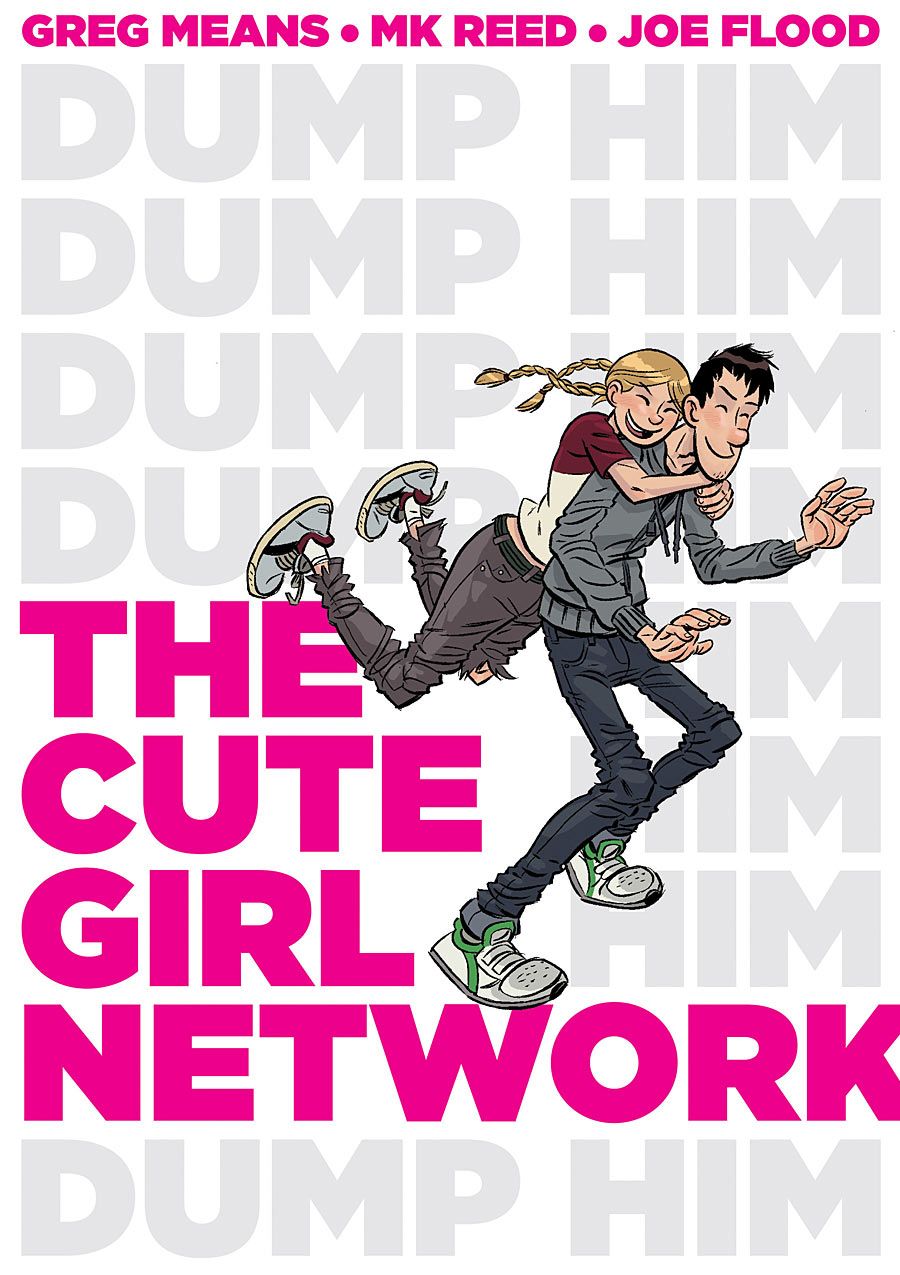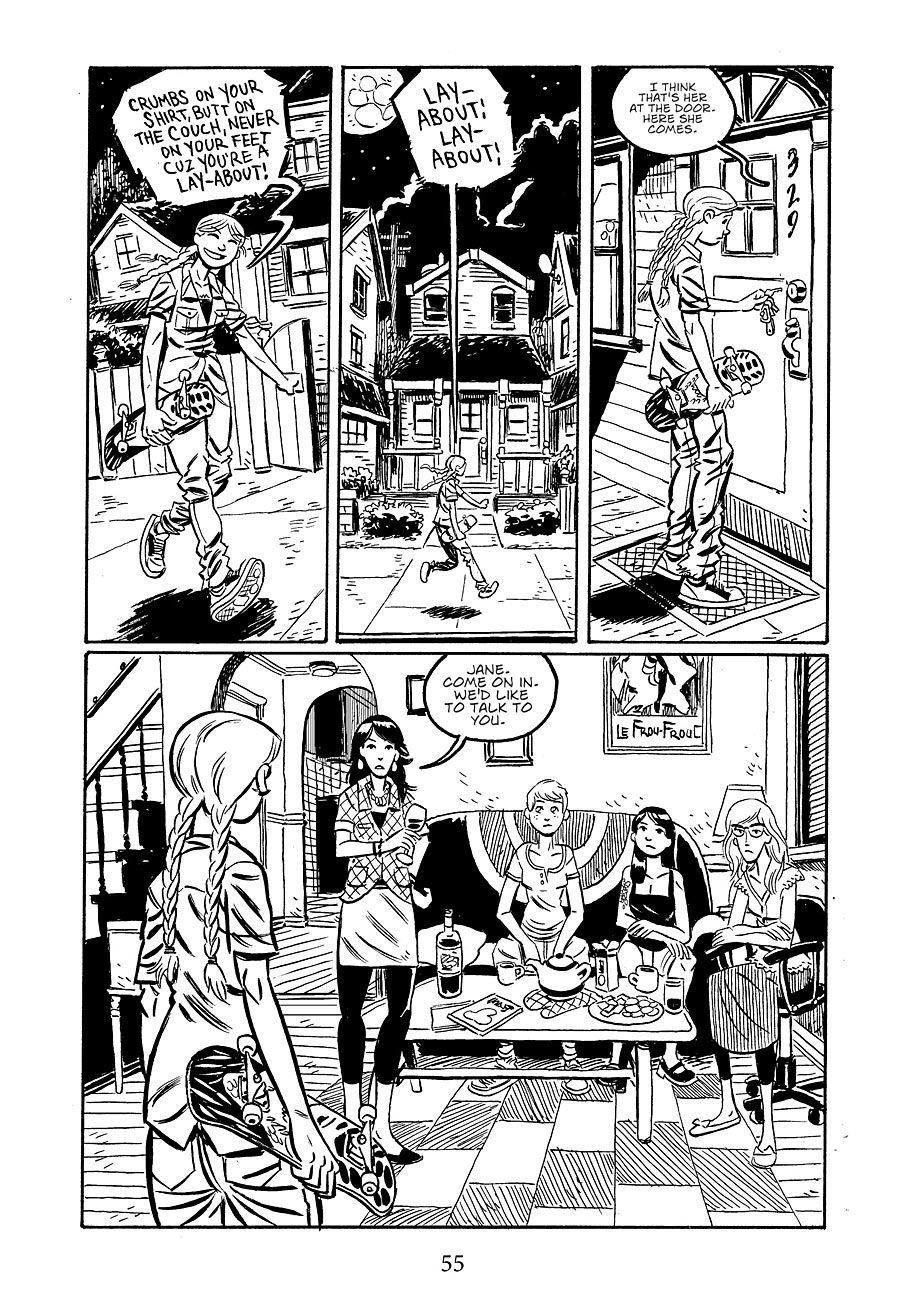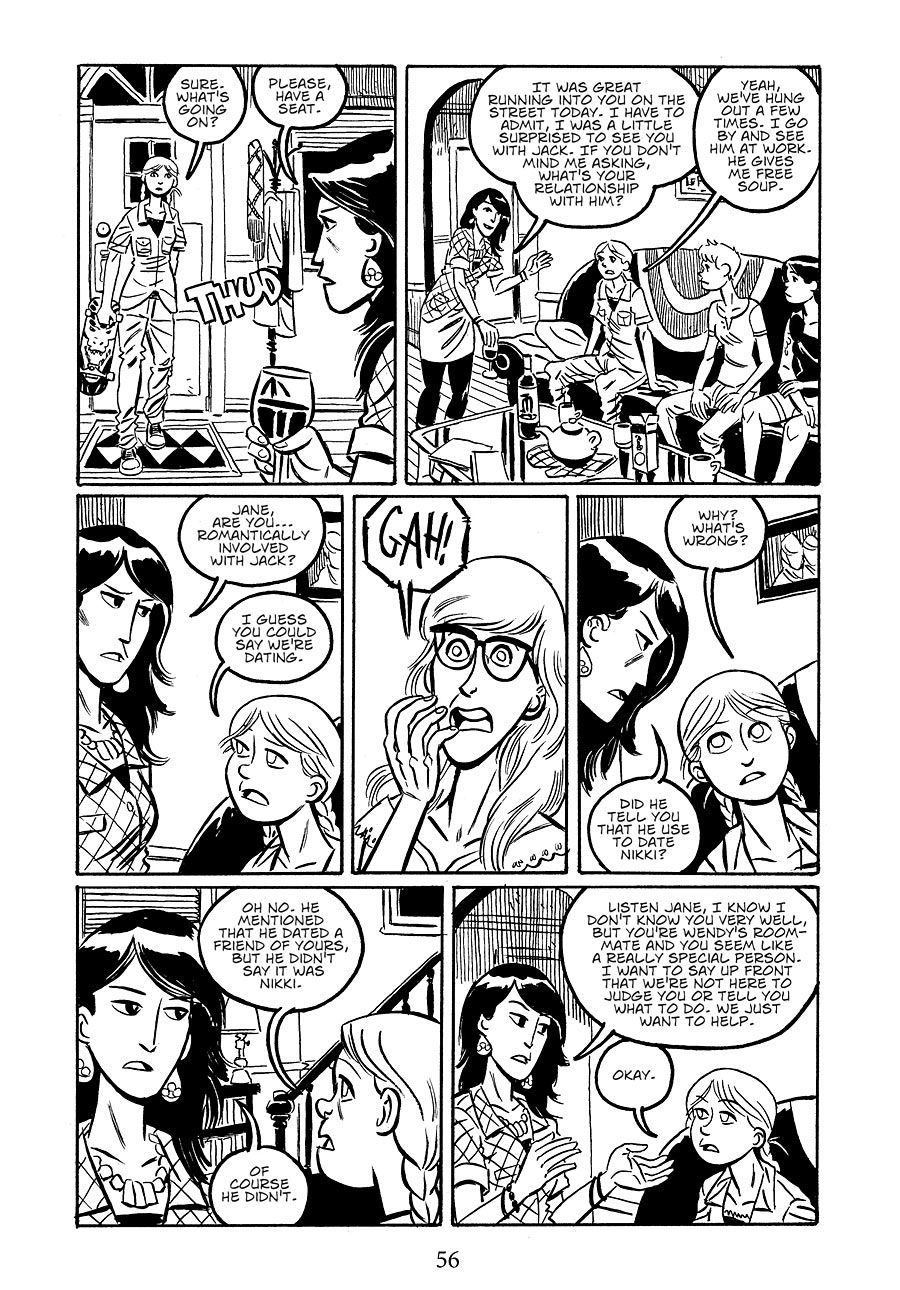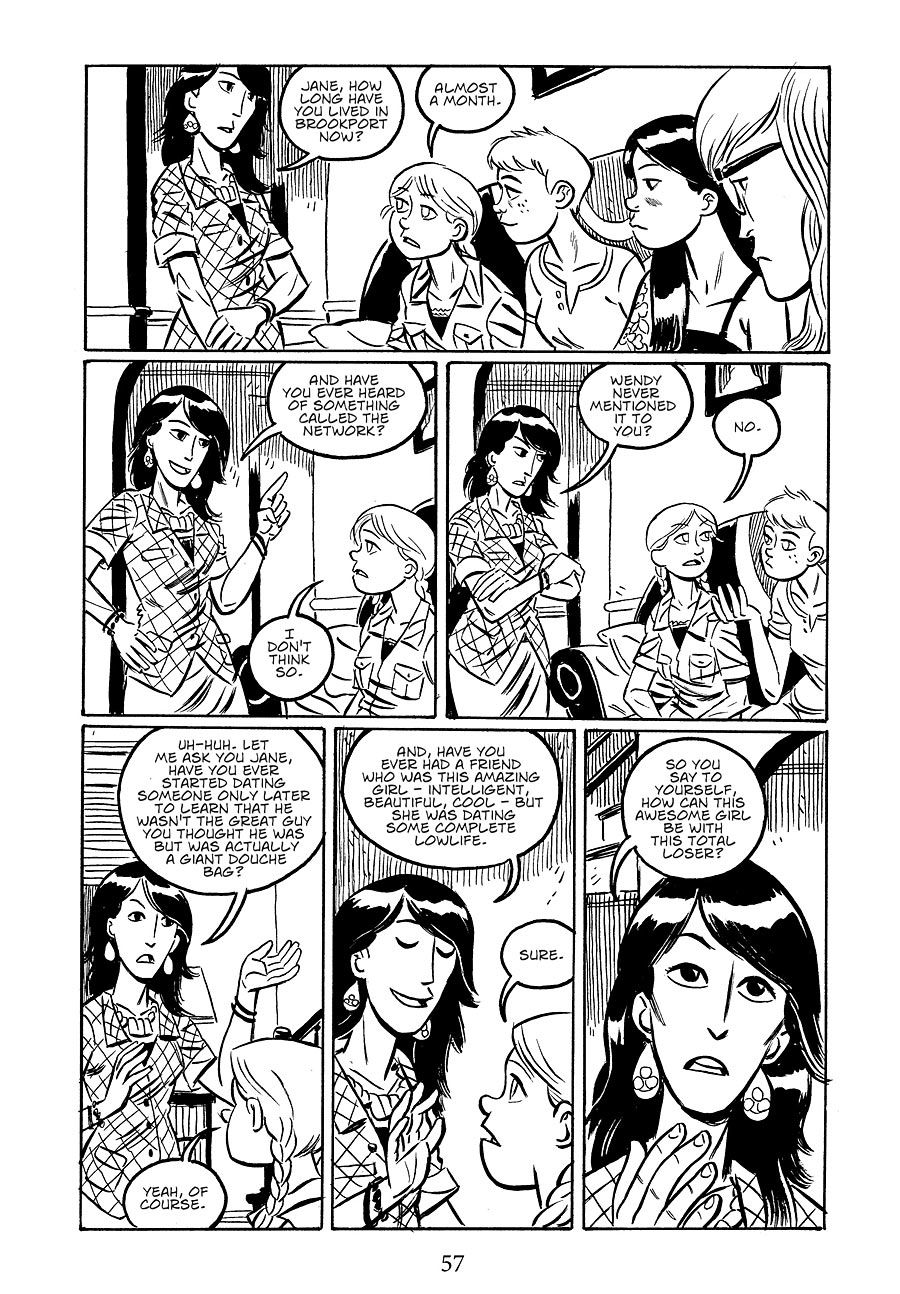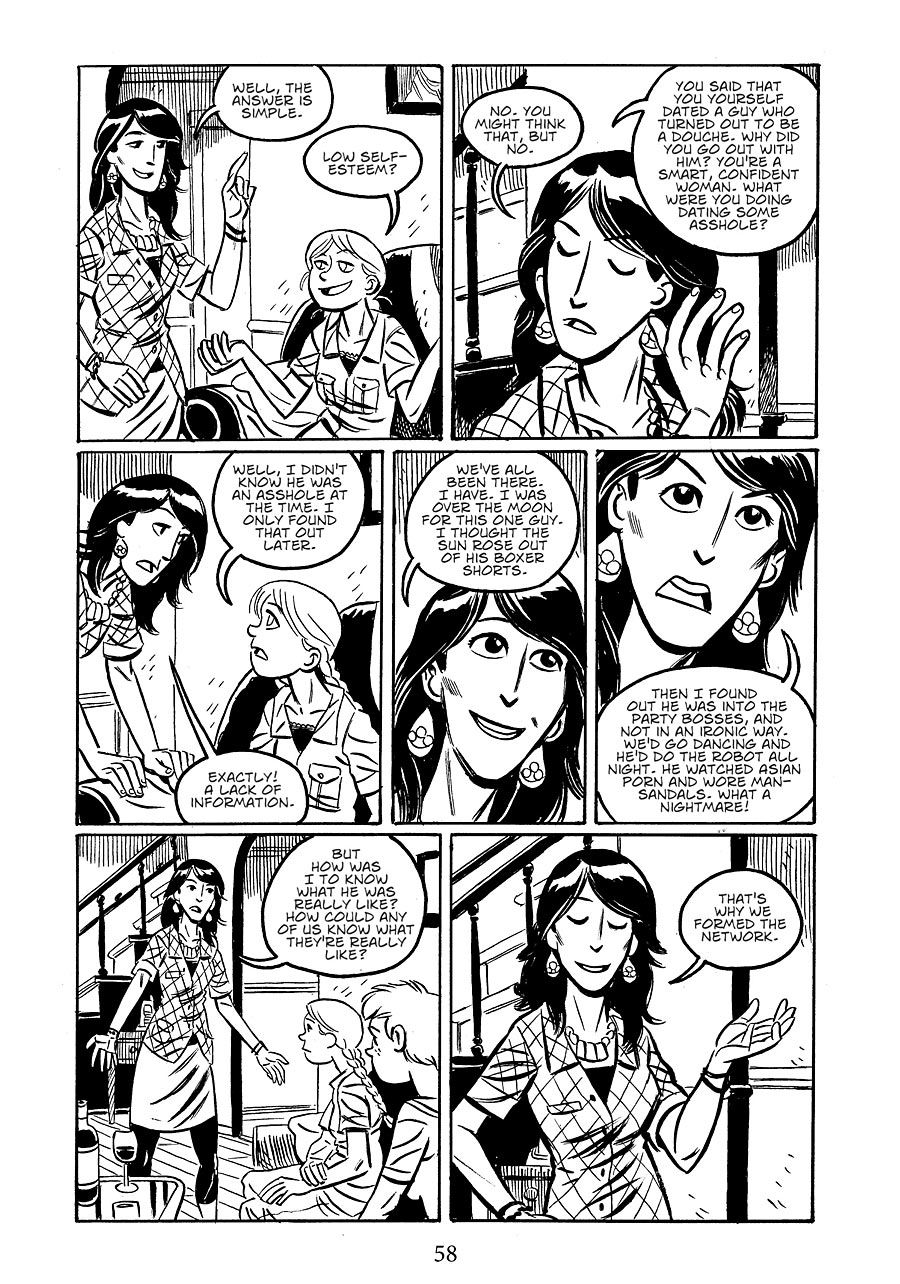Greg Means is a writer and editor who runs the small publishing company Tugboat Press and edits the Ignatz Award-winning anthology "Papercutter." MK Reed has written a number of small press books, including some for Tugboat Press, whose book "Americus" was released by First Second Books in 2011. Artist Joe Flood is best known for his last book, the First Second release "Orcs" where Flood collaborated with novelist Stan Nicholls. The three creators have collaborated on a new graphic novel from First Second, "The Cute Girl Network."
It's a romantic comedy that opens with a "meet cute" between the two protagonists and features a formal "network" in this town where women vet dating prospects in a way that's strange, funny, troubling and ultimately very true to what many of us have gone through in terms of coming to terms with other people. The book, which is on sale now, has received tremendous advance praise from the likes of Kate Beaton, Meredith Gran and Liz Prince. Means, Reed and Flood spoke in depth with CBR News about the project and their collaboration.
CBR News: Where did "The Cute Girl Network" begin?
MK Reed: Greg jokingly e-mailed me about his romantic prospects and having to meet new girls at the bus station before they found out about his past, and I told him the Cute Girl Network would always be one step ahead of him. Then he made me write this book with him.
Greg Means: When I presented MK with the first loose outline, her response was, "Oh, you were serious about that?"
Who are these two characters who encounter one another in an entertaining meet cute at the book's opening?
Reed: Jack works at a soup cart on the street. Jane's a skater who wipes out in front of him on the way to work. While "girl falls in front of attractive man" is totally a rom-com cliche, it's usually done in a way more patronizing way, like, "Why did that idiot think she could carry so many cakes?!" instead of through athletics requiring focus.
Means: Jane is a pretty tough gal. She leads a simple life but can handle most anything that's thrown her way. She can be a little grumpy but I think that's a natural reaction to being one of the few girls in the male dominated world of skateboarding. She's attracted to Jack for his gentle nature and his enthusiasm for life. Also, she find his clumsiness endlessly endearing.
How did the process of writing it go? How did the two of you work together from opposite ends of the U.S.?
Reed: Internet magic! We wrote a chapter at a time over Google Docs and talked once or twice a week about rewrites. It was mostly pretty fun and went really fast. A lot of the scenes ended up being really blended & I have no idea which one of us wrote them now.
Means: It was great because if one of us got stuck on a scene, the other could come in to help. And if we weren't sure about a joke, we could try it out to see if the other person laughed. If I got a "Eh, that's okay I guess" from MK, I knew if was time for a rewrite.
At what point did you know there had to be a discussion of a book that is not "Twilight" in the book?
Reed: When we were trying to figure out a gathering of ladies that would be in Jane's home with her roommate. I did not know I'd be writing a prose excerpt from the book until the very end of production when we had blank pages to fill.
Means: MK is a master at writing great (hilarious) fake genre fiction. Her fake fantasy novel "Apathea Ravenchilde: The Huntress Witch" from her last graphic novel "Americus"is one of my favorite fake books ever.
Did you know the ending from the beginning?
Reed: I don't actually remember.
Means: The end of chapter six was always a goal we were writing towards. The moment when Jane makes up her mind. All of chapter seven was a surprise.
I did love that the book captures this certain milieu of being in your twenties, having roommates, so-so jobs, figuring out what you want. How important was that and how big a deal was it for the story to have such a setting?
Means: Though MK and I aren't in our twenties anymore, the world Jack and Jane live in is very familiar to us. We were both young punk kids at one point, not so long ago. We knew we could get the details of that world right and that it'd be a fun setting that a lot people could relate to. That is an exciting time in most people's lives, but also a time when you start to figure out who you are as an adult.That made it perfect for Jane and her struggle with The Network.
Reed: Jack's room is based on mine. I did live in a closet for the first three years I lived in Brooklyn. 56 square feet, with a window & ceiling fan. And then my boyfriend started hanging out at my house all the time, so I basically split it with him for a year and a half, until he moved in.
In some ways Jack sounds like a character that fits into what many of us have come to expect in a lot of movies, the twenty-something slacker. But he's not quite and he doesn't have the typical arc we expect from such films. He doesn't really have an arc. Talk about trying to make sense of him and how to present him to the reader.
Reed: I guess he's kind of like the girl in most romantic comedies? Like he's super accident prone with a bit of a checkered romantic past, but a really huge sweetheart. But he's not there to save a smart, nice young woman from the challenging, stressful work world, nor is Jane going to pull him out of the rat race. We cribbed a lot of his experiences from things that'd happened to us and our friends.
Means: Jack's seeming inability to change is one of the things Jane has to wrestle with when deciding to dump him or not. If she's going to stay with him, she's going to have to accept him for who he is. That's hard because he's kind of a mess and could easily end up breaking her heart. I think most readers know someone like Jack, a screw-up. He means well and tries his best, but fails more often than not. I think we've all felt like that at one point or another, especially in our romantic relationships.
Joe, a lot of people know you from your last book "Orcs," which is a very different book. What attracted you to "The Cute Girl Network?"
Nicholls & Flood Battle "Orcs: Forged for War"
Joe Flood: Yeah, "Orcs"was a real blood bath, lots and lots of gore. my first book "Hellcity"had lots of that stuff too.I think the most blood in "The Cute Girl Network"is when Jack gets a nosebleed. Those first two books were really what the 16-year-old version of myself wanted to draw; violence, monsters and sexy ladies. Up to this point all of my main female protagonists had been femme-fatale types. I wanted to draw real, actual women, doing ordinary everyday things, some of whom are, in fact, cute. I consider it something I'm rather good at it, drawing cute girls, so when the opportunity came along to work on a book that highlighted my ability, I jumped on it.I'll probably going to back to the realm of fantasy and creatures with sharp teeth and horns on their faces at some point in the future -- that stuff is awesome -- but I also like to show my range as an artists because variety is the spice that make existence extra nice.
Talk a little about your approach to this book because you use this loose kinetic style with the characters drawn pretty cartoony and the backgrounds drawn in a more detailed, realistic fashion.
Flood: Hmmmm, cartoony, that term has followed me around a lot when it comes to people talking about my art. I usually have a chip on my shoulder about that and I can get pretty defensive when I hear that word and my art used in the same sentence. It's usually followed by the phrase, "if you're into that kind of art," as if drawing simplistic is a negative.It's something that I've come to accept and take it as a compliment, no matter the context.It's absolutely true, it was my intention to make the characters simplistic and the backgrounds detailed.It's a very common comic art trope and is used with great success by many of the greats.I hope I used it to some degree of success in this book.A simplistic drawn face, if done well, can be a blank slate that the reader can step into and experience the world from that character's point of view, and that's where the vivid backgrounds come in. They complete the illusion and make the narrative more believable even though it's just printed ink on a page.
I'm curious how your thoughts on this idea of the network have changed over the course of writing the book. I mean it's a fun idea, but the character of Harriet especially treats it as something that ultimately would condemn all of us to be single, and Jane takes the attitude of "we've all had bad relationships."
Reed: I think it's the kind of a thing girls do all the time. Once in college someone I was put on a class project with for one afternoon made me a list of specific dudes not to date and frats to avoid. I don't even remember why or like any other details about her, just that I kept it on my fridge for months because she included reasons why they were terrible and it was hilarious.Do dudes not know women do this already? We talk about creeps.
Means: I just kind of formalized it into a citywide affair. And Harriet's stance is a super logical one: save her friends from dating men who will end up hurting them. Jane just has a different standard of what constitutes a creep and what kind of expectations she has from a boyfriend. If we ever do a sequel, the Network will definitely be the good guys in that one.
Would you date Jane or Jack?
Means: Heck yeah! Either one! Both! I'd love watching Jane skateboard and I could get free soup from Jack. I bet they're dynamite in the sack!
Reed: I pretty much married Jack. There's at least one scene that was ripped straight from one of my first dates with my husband -- they're both super tall, rail thin, and total sweethearts.
"The Cute Girl Network" is on sale now from First Second Books


